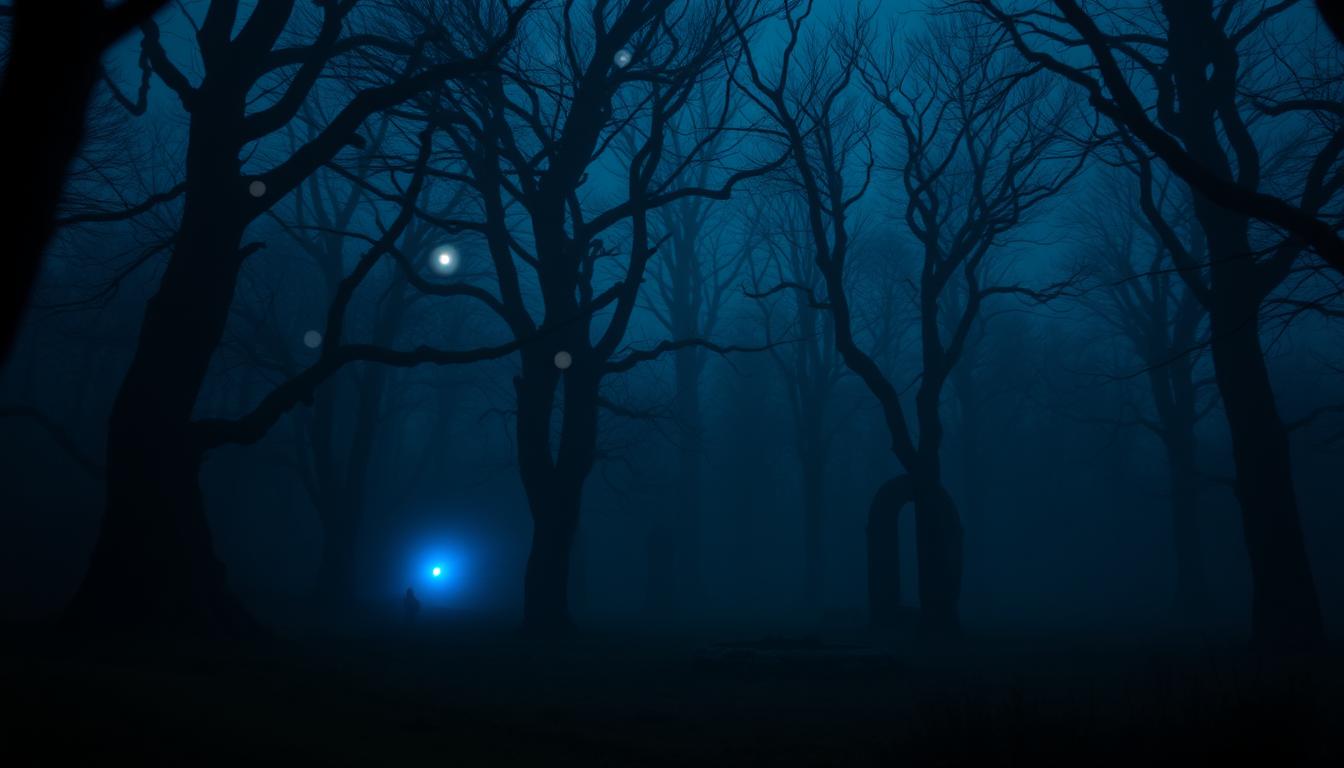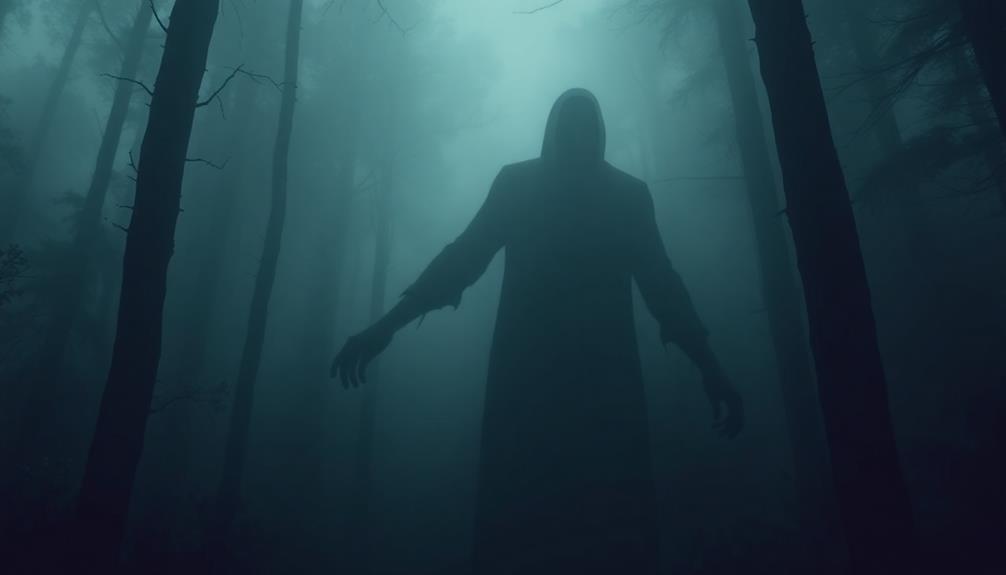Have you ever found yourself mesmerized by a tale that seems to blend the extraordinary with mundane reality? It’s an experience we all share—moments when stories of ancient myths and folklore narratives stir something deep within us. These narratives do not merely occupy the pages of books or the airwaves of our conversations; they inhabit our hearts, connecting us to a rich tapestry of culture, identity, and shared human experience. As you embark on this exploration of legend origins, you will find not only captivating tales but also insights into how our ancestors understood the world and themselves through the lens of mythical stories.
Every culture has its share of legends—whether it’s the ghostly whispers of haunted places, the mysterious creatures lurking in the shadows, or the profound tales of gods and heroes. They shape our perception, offering perspectives that blend truth and imagination. By delving into the world of lore exploration, you will uncover how these timeless tales have shaped human existence, fostering community bonds, conveying moral lessons, and offering comfort in the face of uncertainty.
Key Takeaways
- Myths often reflect core cultural values and beliefs.
- Folklore narratives create a sense of community and shared identity.
- Many legendary creatures have origins in real-world observations.
- Ancient myths often carry hidden truths about human nature.
- Storytelling has evolved but remains a powerful tool for understanding life.
Introduction to Myths and Folklore
Myths and folklore are rich threads woven into the tapestry of human culture. These narratives do more than just entertain; they illuminate shared values, fears, and aspirations, offering a window into the collective psyche of societies. The terms myth, folklore, legend, and fairy tale are often used interchangeably, leading to confusion about their distinct roles in cultural narratives.
Folklore origins trace back to oral traditions, where fictional stories about people and animals circulated from one generation to another. These folktales often impart vital lessons on coping with life’s trials and tribulations. Common themes emerge across cultures, showcasing humanity’s shared experiences and struggles.
Legends, on the other hand, assert a connection to historical figures or events, though they often lack substantial evidence. Stories like those of King Arthur and Robin Hood illustrate how legend traditions blend history with imaginative storytelling, captivating audiences with their mix of fact and fiction.
Fairy tales introduce you to fantastical elements and are traditionally aimed at younger listeners, distinguishing themselves from other forms by their moral lessons and magical contexts. In the realm of myth criticism, scholars analyze common threads and patterns within these diverse stories, revealing the underlying truths and societal norms they uphold.
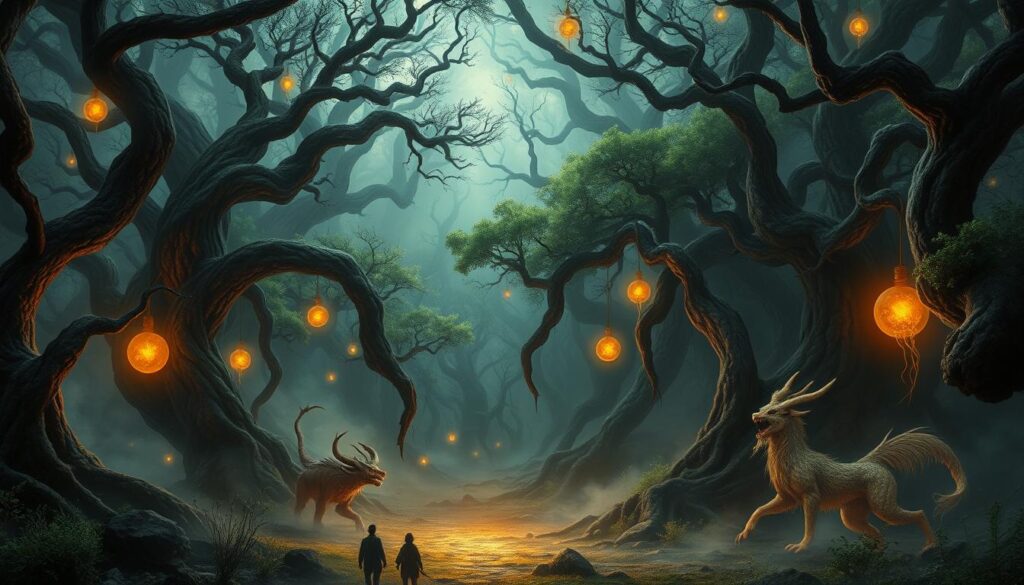
As you delve deeper into the world of myths and folklore, appreciating their significance becomes paramount. Each tale, whether a myth or a folktale, offers a cultural narrative that aids in understanding human nature and the complexities of the world around us.
| Category | Description | Purpose |
|---|---|---|
| Myth | Narratives concerning divine characters set outside of historical time | Validate social norms and power dynamics |
| Folklore | Fictional tales circulated orally about people and animals | Teach coping mechanisms and life lessons |
| Legend | Stories presented as historical but often unsubstantiated | Blend history with imaginative storytelling |
| Fairy Tale | Magical stories aimed primarily at children | Entertain while imparting moral lessons |
| Fable | Short stories with personified characters that convey moral messages | Teach explicit morals through simple narratives |
Understanding the Significance of Legend Origins
The significance of myths holds a vital role in shaping our understanding of cultural identity. These narratives offer a glimpse into the legendary beginnings of societies, igniting the imagination while conveying profound moral lessons. Legends serve as bridges to our past, allowing people to connect with their heritage through shared experiences and beliefs.
The folklore importance lies in its ability to explain natural phenomena and the nuances of human existence. Myths often emerge from experiences unique to specific cultures, thus reflecting their values, fears, and aspirations. Take, for instance, the saying “The Man, the Myth, the Legend”; this phrase emphasizes how historical figures, whether from mythology or more contemporary culture, have shaped our perceptions of greatness. It reveals how individuals can become icons, leaving lasting impressions through their actions, which transcend time.
Folklore accumulates in collective memory, merging truth with fantasy. Over generations, the tales transform, enchanting audiences with both reality and fable. Consider the enduring legends like that of Brutus, tied to the origins of Britain, showcasing how myths can provide a sense of belonging. Additionally, British folklore featuring creatures like the Loch Ness Monster and stories that originate from varied cultures, such as Cinderella or even Beowulf, illustrates the rich tapestry of humanity through narratives that unite distinct cultural identities.
As you explore the significance of myths, you begin to connect with the cultural narratives that shaped countless generations, finding meaning in the legendary beginnings and appreciating the underlying values that persist to this day.
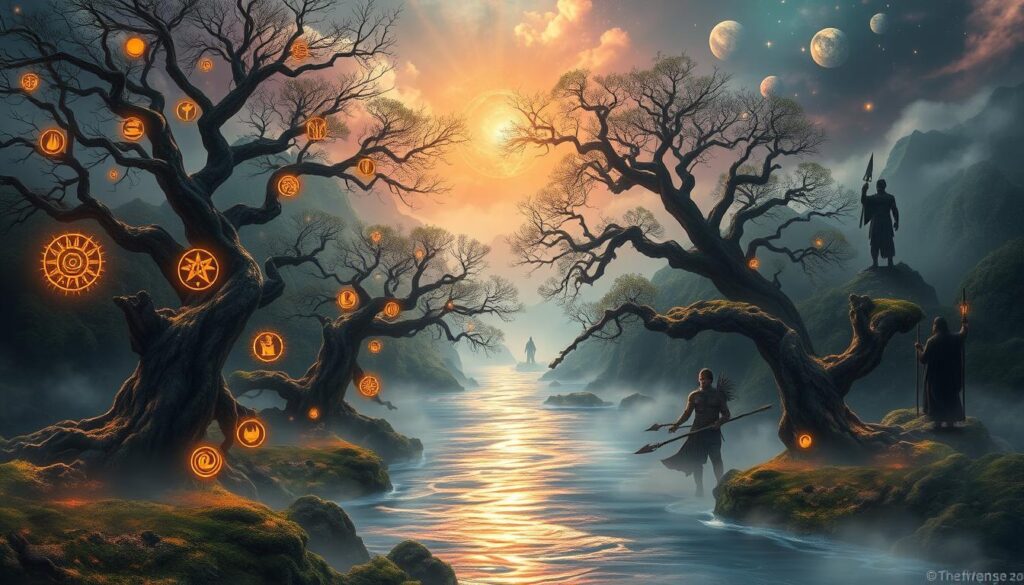
Ancient Civilizations and Their Folklore Narratives
Throughout history, ancient civilizations have shared rich civilization folklore that reflects their societal values, challenges, and beliefs. These narratives have preserved themes and archetypes that resonate with the human experience. Across cultures, ancient myths encode observations of significant geological events, offering a glimpse into the collective memory of catastrophic occurrences.
For instance, tales of devastating floods appear in various cultures, suggesting a shared recollection of such events. The volcanic eruption of Santorini around 3,500 years ago likely inspired the legendary account of Atlantis. Similarly, the narrative of Pele, the Hawaiian goddess, may have originated from Kilauea’s dramatic lava flows. Such stories reveal how narrative origins intertwine with real geological phenomena.

In Greek mythology, which is often regarded as a cornerstone of cultural legacy, the oral traditions from the Bronze Age were eventually captured in texts by poets like Homer and Hesiod. The mythological tales of heroes like Heracles and Pandora not only entertained but also embodied the struggles and ideals of their society. The twelve Olympian gods captured the essence of human traits, while legendary figures like Pegasus and the Cyclops showcased the imaginative realms of ancient storytelling.
These enduring stories of the past continue to shape our understanding of cultural heritage. They resonate in modern literature, cinema, and even fashion, highlighting their timeless appeal. As seen in popular works by authors such as Neil Gaiman and the adaptations of classical tales in mainstream media, the influence of ancient myths persists, revealing the continuity of human creativity and thought across the ages.
Exploring Creation Myths from Around the World
Creation myths serve as profound symbols that offer essential insights into cultural cosmology across various societies. These origin tales illuminate how different communities understand the universe and humanity’s position within it. Each mythical origin can reflect unique values, rituals, and narratives that structure cultural identity.
For instance, the Hindu tradition presents the concept of the Cosmic Egg, or Hiraṇyagarbha, which is revered as the source of the universe. This idea resonates through multiple ancient civilizations, showcasing the interconnectedness of these creation myths.
The Vikings narrate a fascinating tale involving the primordial giant, Ymir. From his body, the Earth is formed, emphasizing themes of transformation and rebirth. His blood creates oceans, bones become mountains, capturing the essence of life emerging from chaos.
The Hopi people’s creation narrative speaks of emergence from underground to the surface, guided by their creator Maasaw. This myth includes the survival of a great flood, symbolizing resilience and renewal within the community’s cultural values.
Maya mythology presents another captivating story, where Hun-Hunahpu’s head impregnates a girl, leading to the creation of twin heroes, embodying the Sun and the Moon. This narrative symbolizes the cyclical nature of life and the beginning of new eras.
Across Native American cultures, the tale of Nanabozho portrays themes of vengeance and survival, where defeating a great serpent allows for the establishment of a new world, introducing values of strength and perseverance.
In Ancient Egypt, the Book of the Heavenly Cow narrates the consequences of Ra’s actions, resulting in human mortality and the responsibility of maintaining cosmic order. This myth illustrates themes of divine power and human agency.
In Finnish mythology, the goddess Ilmatar gives birth after contact with the sea, leading to the earth’s creation. This story highlights the importance of elemental forces in shaping existence.
Moreover, the Chinese creation myth involves a cosmic egg giving rise to the world, with Pangu’s remains playing a critical role, showcasing how mythical origins are essential in providing meaning and context to cultural practices.
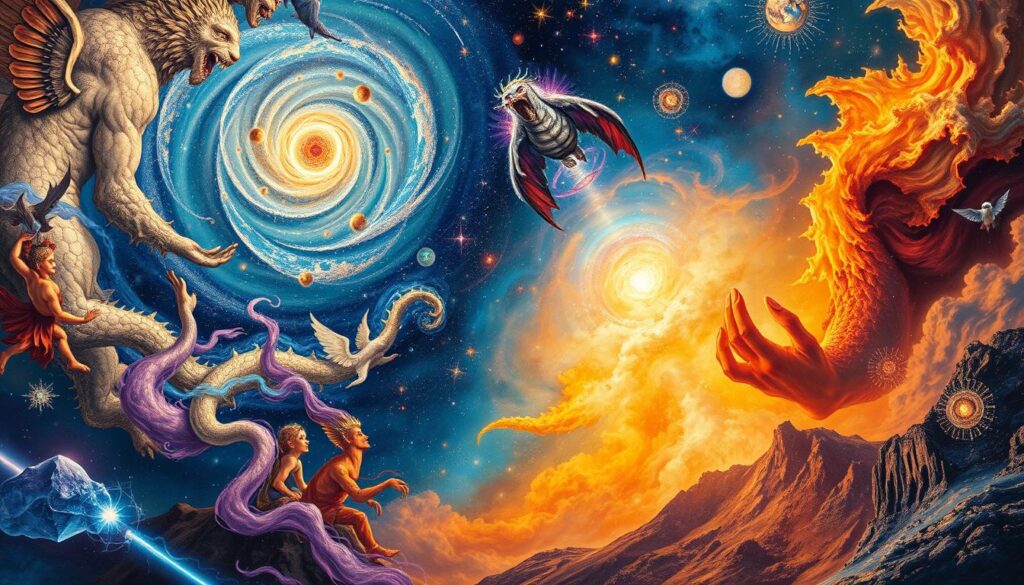
The Role of Myths in Shaping Cultural Identity
Myths significantly influence your cultural identity, linking communities through shared narratives and values. They serve as vital storytelling tools that convey myths and values, reflecting the essence of societal beliefs within a culture. These ancient tales often originate from prehistoric eras where they were passed down verbally before recording became common practice.
In various indigenous cultures, myths reveal the sacredness of the land and the interconnectedness of life. They articulate a community’s tradition and identity, showcasing what matters most to them. For instance, the significance of the Norse myths emphasizes qualities like bravery and honor, essential to the Viking way of life. This deep connection between myth and community values fosters a communal understanding of identity.
Throughout history, mythological stories have offered insights into natural events and human behaviors. The Greek myth of Icarus illustrates the consequences of hubris and ambition, providing moral lessons that resonate across generations. Through these narratives, you can grasp the societal beliefs and cultural norms that define a society’s character.
Besides connecting individuals with their heritage, myths help maintain cultural continuity, ensuring traditions, beliefs, and histories are preserved. In modern contexts, the influence of mythology extends into the realms of literature, film, and art, continuing to shape conversations about fundamental human themes. Thus, understanding your own cultural identity can often be traced through the myths that have shaped previous generations.

Greek Mythology: Insights into Human Nature
Greek mythology provides a captivating exploration into the depths of human nature, especially through the legendary figures like Zeus and Pandora. These mythical narratives delve into universal themes such as power, curiosity, and the moral consequences of human actions. The stories vibrantly reflect the complexities of human traits, showcasing strengths and weaknesses that resonate across time.
The Stories of Zeus and Pandora
Zeus, the chief deity of Greek mythology, embodies various human traits including authority and recklessness. His tales often revolve around themes of power and control, revealing the duality inherent in the human experience. In contrast, the story of Pandora highlights the themes of curiosity and its repercussions. Pandora, famously known for opening a forbidden box, inadvertently unleashes chaos into the world, symbolizing how human curiosity can lead to unforeseen consequences. These narratives serve as both cautionary tales and reflections on behaviors intrinsic to humanity.
Cosmic Reflections of Human Traits
The enduring impact of Greek mythology lies in its rich portrayal of human characteristics. These ancient stories mirror experiences and emotions that we still encounter today. From the optimistic to the tragic, Greek mythology encapsulates a full spectrum of human traits. Recognizing the connection between these mythical figures and ourselves fosters a deeper understanding of our nature, emphasizing that these age-old tales remain relevant in contemporary societies.
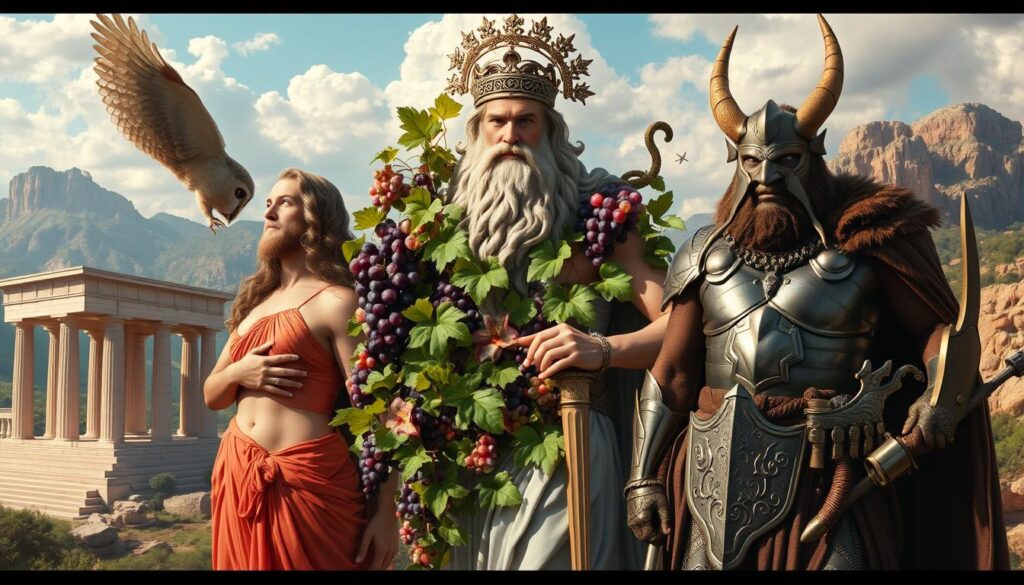
| Figure | Human Trait | Mythical Narrative |
|---|---|---|
| Zeus | Authority | As the ruler of the gods, his stories demonstrate the complex effects of power. |
| Pandora | Curiosity | Her choice to open the box reflects the potential dangers of human inquisitiveness. |
| Prometheus | Intellect | His act of creating humanity illustrates innovation but also warns of consequences. |
| Athena | Wisdom | Representative of strategic knowledge, she embodies the importance of intellect in decision-making. |
Native American Folklore: Legends of Nature and Spirituality
Native American myths reflect a deep reverence for nature and a belief in the interconnectedness of all beings. These cultural tales often emphasize the sacredness of the earth and the vital role it plays in human life. For many tribes, such as the Blackfeet, Crow, and Pawnee, stories about the buffalo serve as symbols of sustenance and survival, showcasing how nature legends help to bind communities through shared values and experiences.

Legends about migrations and the origins of tribes offer insights into Native American spirituality in folklore, illustrating the values and beliefs that shape these cultures. The tales frequently feature a variety of deities and spirits, emphasizing a close relationship between humans and the natural world. The concept of a Great Spirit is central, guiding many narratives and serving as a reminder of humanity’s responsibility to the earth.
Myths often portray animal characters such as Coyote and Opossum, symbolizing traits like cunning and adaptability, in narratives rich with symbolism. The stories may include elements of humor or allegory, reinforcing moral lessons that resonate with contemporary values. The diversity found within Native American mythologies is a testament to the rich tapestry of beliefs held by Indigenous peoples, each reflecting unique cultural perspectives and traditions.
| Tribe | Significant Themes | Notable Figures |
|---|---|---|
| Blackfeet | Buffalo and nature connections | Star-born heroes |
| Crow | Nature legends and spirituality | Coyote, Glooskap |
| Pawnee | Migratory narratives | Manabus, creator figures |
| Arapaho | Animal-human relationships | Old Man (Waziya) |
| Cherokee | Creation myths | Great Spirit |
Legend Origins and the Myths Depicting Magical Creatures
Legends about magical creatures have intrigued cultures worldwide for generations. These tales often bridge the gap between reality and fantasy, revealing deep-rooted beliefs and fears. Two prominent examples are the Bigfoot legends from North America and the significance of the Thunderbird in Native American folklore. Both myths reflect the human desire to explain the mysterious elements of nature through captivating narratives.
Bigfoot: The Elusive North American Legend
Bigfoot stands as a symbol of the wild and unexplored regions of North America. This legendary creature is often depicted as a large, hairy man-like being that roams remote forests. Sightings have been reported for decades, fueling an enduring interest in Bigfoot legends across the United States. Enthusiasts and researchers alike search for evidence, hoping to unveil the truth behind this elusive figure.
Thunderbird: A Symbol of Power in Native Traditions
The Thunderbird occupies a revered space in Native American traditions, embodying the connection between the heavens and the earth. This magnificent creature, often depicted as a giant bird, symbolizes power, strength, and transformation. The Thunderbird significance extends beyond mere folklore; it represents the spiritual aspects of nature and serves as an important cultural emblem in various tribes.
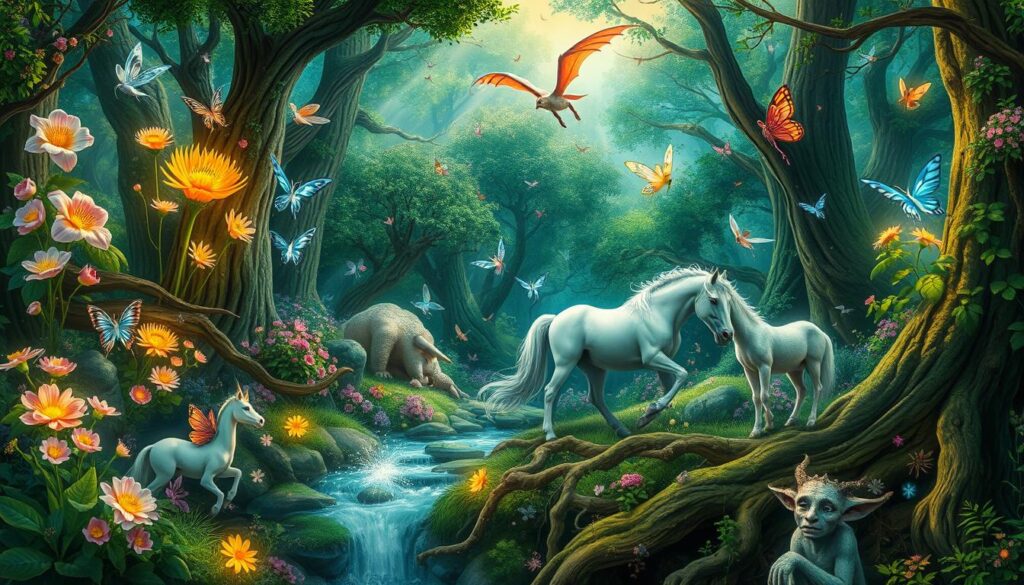
Folklore Tradition in European Cultures
European cultures exhibit a vibrant tapestry of European folklore, deeply rooted in history and communal identity. These folk traditions often reflect significant historical events and societal dynamics, intertwining themes of fear, aspiration, and the extensive human condition.

The influence of Christendom during the Early Modern period has contributed to the shared traditions found across various ethnic and regional groups. Christian mythology plays a pivotal role in many folk traditions, especially evident in customs related to Christmas and All Souls’ Day.
- Common apotropaic gestures, such as knocking on wood and crossing fingers, appear in numerous Western cultures.
- Many elements of European folklore trace back to the Proto-Indo-European peoples from the Neolithic and Bronze Ages, enriched by Classical Antiquity and magical practices.
- Interactions with the Islamic world particularly shaped folklore in regions like the Balkans and the Iberian Peninsula.
Since the 19th century, European folklore has experienced a significant exchange of ideas, particularly influenced by American folklore. This cross-pollination allows for a continued evolution of legendary tales that resonate today.
| Region | Folklore Traditions |
|---|---|
| Northern Europe | Myths of trolls, elves, and Norse legends. |
| Western Europe | Arthurian legends and tales of chivalry. |
| Southern Europe | Folktales of spirits and mystical beings. |
| Central and Eastern Europe | Legends involving Slavic mythology and fairy tales. |
The term “folklore,” first coined in 1846 by William Thoms, highlights the diverse academic pursuit of cultural narratives, where students can choose to study folklore at various levels. The development of this field aligned with the romantic nationalism movement, emphasizing unique cultural expressions through stories, sayings, and songs.
According to William Bascom, the four main functions of folklore include providing escape from societal pressures, validating cultural identity, serving as a teaching tool, and enforcing social norms. In the 19th century, the perception of “the folk” evolved from rural, illiterate communities to encompass urban populations, showcasing the ever-changing nature of folk traditions.
Ancient Myths of India: The Cosmic Cycles
In exploring Indian mythology, one discovers a vast landscape filled with rich folklore narratives that delve into the cyclical nature of existence. These narratives encompass themes of creation, preservation, and destruction, illustrating profound insights into the universe’s workings. Central to this understanding are the cosmic cycles, which reflect Hindu philosophies and Vedic tales guiding the flow of life and the cosmos.
A significant aspect of Hindu cosmology involves three fundamental gunas: sattva (goodness), rajas (passion), and tamas (darkness). These qualities constitute all matter and define the interaction between the spiritual and physical realms. Pradhana, the root matter, begins the cycle through a primal desire to create, emphasizing that matter lacks consciousness or will to act autonomously.
As you grasp the essence of these Vedic tales, you gain insights into how manifested elements of creation interact with living beings. Subtle elements like ahamkara (ego), buddhi (intelligence), and citta/manas (mind) form foundational aspects of human nature, while the physical elements—space, air, fire, water, and earth (pancha bhuta)—connect to our senses and sensory experiences.
Time in this framework is not linear; it unfolds in infinite cycles. Each cycle encapsulates periods of creation and destruction, with current existence being merely a chapter in an eternal saga. Hinduism, one of the world’s oldest religions, provides a glimpse into these vast cycles through its core texts, illustrating that every new creation inevitably leads to destruction and rebirth. This understanding enriches your appreciation for the deeper workings of the universe, as articulated within Indian mythology.

Mythical Tales from Asia: Dragons and Guardians
Across Asia, dragons play a significant role in folklore, symbolizing not only power but also prosperity and harmony. These magnificent creatures appear in various forms, showcasing distinct characteristics within different cultures. You might find it fascinating to explore the variations of dragon legends and their meanings, as well as the powerful Yeti stories that depict these guardians of the wilderness.
The Variations of Dragon Legends
Dragons in folklore demonstrate a rich tapestry of interpretations throughout different Asian cultures. The Chinese dragon, known as “long” (龍), is a snake-like creature with four legs, primarily associated with water control and imperial power. Their symbolism is reflected in:
- Emperor representation: Chinese emperors often adorned robes with dragon motifs during the Tang dynasty, symbolizing their imperial status.
- Prosperity: The dragon is linked to good luck and rain deities, showcasing its role in fostering harmony within nature.
- Cultural symbols: The Azure Dragon is a revered symbol of the Chinese emperor, used in state emblems throughout various historical dynasties.

In Japanese mythology, dragons are less prominent compared to spirits and gods. They are depicted as symbols of wisdom and strength, with notable figures like Yamata no Orochi and Watatsumi often referenced. Unlike the Chinese dragon, which embodies positive attributes, Japanese dragons can exhibit both benevolent and malevolent traits depending on the tale:
- Kiyohime, who transformed into a dragon out of rage, showcases the complexity of dragon narratives in Japanese folklore.
- Mizuchi, the water dragon from Kawashima River, represents the perilous elements associated with these creatures.
Cultural Interpretations of the Yeti
The Yeti, often perceived as a guardian creature in Himalayan culture, possesses a rich history filled with intriguing stories. These Yeti stories reflect humanity’s connection to the natural world, representing an enigmatic protector of the mountains. Different cultures attribute various meanings to the Yeti, including:
| Cultural Aspect | Significance |
|---|---|
| Symbol of Mystery | The Yeti embodies the unknown elements of nature, evoking both fear and fascination. |
| Guardian of Nature | Many view the Yeti as a protector of the mountain ecosystems, underscoring the importance of preservation. |
| Spiritual Connection | Beliefs often portray the Yeti as a link between humanity and the spiritual realm. |
These mythical tales from Asia, whether linked to dragons in folklore or the enigmatic Yeti, exemplify the diverse cultural narratives that shape our understanding of guardianship and the relationship with nature. As you delve into these stories, you uncover a world rich with symbolism and meaning, reflecting the intricate tapestry of human experience.
The Structure of Legendary Tales: Archetypes and Themes
Legendary tales possess a unique legendary structure that resonates deeply across cultures. Common archetypes in myths such as the hero’s journey and the trickster figure provide a foundation for storytelling that captivates audiences. Understanding these components sheds light on the intriguing storytelling themes that permeate narratives throughout history.

For instance, the Persian epic Shahnameh chronicles the reign of fifty kings, highlighting a detailed account of rulership transitions. Notably, only five of these kings are depicted favorably, while the remaining rulers display significant flaws. This aspect illustrates the importance of character complexity in legendary tales.
The legendary section of the Shahnameh tends to focus on more famous stories, indicating a concentration on key events and characters that leave a lasting impact. Rostam, the central figure, showcases the intricacies of heroic narratives and moral dilemmas, particularly his conflicts involving family ties.
| Archetype | Example | Description |
|---|---|---|
| Hero’s Journey | Rostam | A character facing numerous trials that ultimately lead to growth and self-awareness. |
| Trickster | Various characters | Figures using cunning and deception to navigate moral complexities. |
| Father-Son Conflict | Siyavosh, Esfandiyar | Recurring theme representing complex relationships between generations. |
| Flawed Leadership | Kings of Shahnameh | Showcases the imperfection of rulers, emphasizing their human vulnerabilities. |
| Conflict | Murder of Iraj | Initiates a cycle of wars, highlighting ongoing struggles between opposing forces. |
Such narrative analysis reveals how legendary tales encapsulate societal values, ethical dilemmas, and gender roles. As you engage with these stories, recognizing the enduring impact of these archetypes and themes enriches your understanding of human experiences reflected in myths and folklore.
Connecting Myths to Modern Society
Myths have an undeniable impact on modern culture. You will find modern parallels in literature, film, and social movements. These ancient stories often provide frameworks that resonate with contemporary issues, allowing you to explore deep-seated themes that transcend time. For example, the Great Flood narrative appears in multiple cultures, illustrating a shared human experience.

Folktales represent another facet of folklore today, offering insights into everyday life and morality. Unlike myths, which present archetypal characters and grand narratives, folktales focus on relatable experiences and coping strategies. This connection supports the relevance of legends in addressing modern questions about identity and ethics.
In contemporary entertainment, Disney movies exemplify the trend of retelling ancient narratives through a modern lens. Greek mythology, in particular, draws inspiration from ancient tales, influencing films like “Clash of the Titans” and series such as “Hercules: The Legendary Journeys.” These adaptations highlight the enduring legacy of myths in contemporary culture.
- The rise of digital media has changed how legends are shared, leading to decreased popularity in traditional storytelling.
- Walter Benjamin emphasized the decline of storytelling as an art form, a concern that resonates in today’s fast-paced world.
- Community creation was essential in ancient storytelling, highlighting the importance of collective identity.
Classes combining storytelling with activities like yoga are emerging, further underscoring the significance of narrative in modern life. Exploring these connections reinforces the idea that ancient myths and legends not only shape modern literature and artistry but also reflect your journey through identity and moral understanding.
Understanding these stories enhances appreciation for the deeper themes present in today’s cultural landscape, reminding you that the resonance of myth is as strong now as it was centuries ago. The study of mythology is crucial in navigating the myriad of narratives that continue to populate your world.
The Timeless Allure: Why We Continue to Share Legends
The allure of legends captivates your imagination and resonates deeply within your soul. As stories shared across generations, these narratives shape the cultural continuity of societies, allowing individuals to connect with their roots and each other. Legends serve as bridges between ancient times and modern life, illustrating the timeless human experience.
Many legends are rooted in historical events or figures, with over 80% tracing back to reality. This deep connection infuses these tales with significance, transforming them into captivating stories. Alongside history, around 70% of legends convey moral lessons through allegorical storytelling. This shared understanding sparks interest in the underlying messages, making legends relevant and meaningful.
The stories of lost civilizations, such as Atlantis and the Trojan War, stimulate curiosity and debate, serving as captivating examples of the mysteries woven into our shared history. As you explore these enduring tales, consider how they reveal humanity’s desires, fears, and aspirations. The Arthurian legend emerged during the Middle Ages, symbolizing a quest for unity amid chaos. Similarly, the emergence of vampire folklore during plague periods reflected anxieties about disease and death.
Larger-than-life characters often embody the archetypes of heroism, present in 90% of legends globally. These transformational journeys resonate well with audiences seeking relatable narratives. Cryptids, like the Loch Ness Monster, continue to intrigue despite scientific skepticism, illustrating the persistent fascination with the unknown. Furthermore, legends have inspired more than 60% of art and literature, showcasing their profound influence on creativity.

Today, modern adaptations cater to evolving audiences while honoring tradition. From book series to digital media, the representation of ancient myths remains vibrant and relevant. This adaptability showcases how legends embody universal symbols and archetypes, tapping into a collective unconscious that connects humanity.
Ultimately, the continuous sharing of legends fosters a sense of belonging and cultural identity, enriching your experience as you engage with these narratives. The interplay between myths in modern life and age-old legends reveals a pattern that transcends time, perpetuating the enchantment of storytelling in our daily lives.
The Intersection of Science and Myth
Understanding the relationship between myths vs. science reveals a fascinating exploration of cultural narratives and empirical truths. Myths often serve as mythical explanations for unexplainable phenomena, but scientific inquiry provides alternative interpretations that can coexist alongside these age-old stories.
The Section on Folklore and Science investigates this intricate relationship, sponsoring an annual Folklore & Science Prize of $750, with an additional $250 allocated for travel to the annual meeting. This initiative highlights a commitment to encouraging scholarly work that delves into cultural science and the intersections of different fields.
Bridging gaps between folklore and science, the section hosts a Climate Interest Group focusing on how expressive culture and folklife intersect with climate and environmental changes. This group promotes discourse among members who are passionate about the influence of cultural narratives on contemporary scientific challenges.
Every year, the section convenes special panels for the senior prize winner, allowing an enriching dialogue between scientific experts and scholars of folklore. The founding members, like Sandra Bartlett Atwood and Brandon Barker, seek to encourage cooperation across disciplines, facilitating interdisciplinary panels at various conferences, including those beyond the American Folklore Society.
Inspiration can be found in the works of Roger Caillois, whose 1938 publication, Le mythe et l’homme, explores the laws of myth formation and its connection to human behavior. Caillois introduces the idea of “diagonal science,” providing a method to bridge the gaps between different scientific fields and folklore, ultimately enriching our understanding of both.
An annual investment in panels and prizes promotes new ideas and reiterates the importance of examining how myths interact with scientific narratives. By exploring these connections, you can appreciate the dual nature of human thought, navigating between myths vs. science in your quest for knowledge.
Conclusion
In wrapping up this exploration of legend origins, it’s clear that the summary of myths and their remarkable narratives weave a rich tapestry that connects generations. These stories inform our understanding of the world and entertain, ensuring that the legacy of folklore endures across cultures. From the striking legends of King Arthur to urban legends that evolve with society, each narrative serves a purpose, reflecting the cultural importance of shared human experiences.
As we examine these tales, we recognize that they often arise from a blend of historical basis and imaginative elements, establishing a unique space between belief and reality. This distinction highlights the ongoing journey of how we interpret our past and present. Legends hold a mirror to human nature, challenging us to contemplate our actions and values in a rapidly changing world.
Ultimately, understanding legend origins is not merely an academic exercise; it’s a way to appreciate our collective heritage and foster connections within our communities. The stories we share continue to resonate, ensuring that the rich legacy of folklore remains alive in our hearts and minds for generations to come.


